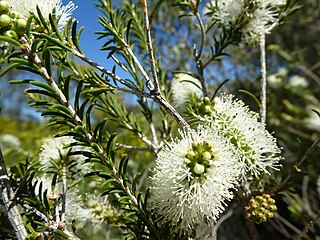
Eremophila subteretifolia, commonly known as Lake King eremophila, is a flowering plant in the figwort family, Scrophulariaceae and is endemic to Western Australia. It is a creeping, prostrate shrub with narrow, sticky, dark green leaves and distinctive orange-red to yellow flowers. It is a rare plant which grows near the edges of salt lakes.

Melaleuca rhaphiophylla, commonly known as swamp paperbark is a plant in the myrtle family, Myrtaceae and is endemic to the south west of Western Australia. It has narrow, needle-like leaves and profuse spikes of white or yellowish flowers at variable times throughout the year. As its common name suggests, it is usually found in salt marshes, or swamps or along watercourses and occurs over wide areas of the south-west.

Beaufortia sparsa, commonly known as the swamp bottlebrush, is a plant in the myrtle family, Myrtaceae and is endemic to the south-west of Western Australia. It is an erect or spreading shrub with round, dished leaves crowded on the younger stems, and bright red flower spikes in the warmer months.

Eremophila lactea, commonly known as milky emu bush, is a flowering plant in the figwort family, Scrophulariaceae and is endemic to Western Australia. It is an erect shrub with its branches and leaves mostly glabrous but with white blotches due to the presence of dry resin. It is a critically endangered plant species mostly found in disturbed areas such as roadsides.

Eremophila scaberula, commonly known as rough emu bush, is a flowering plant in the figwort family Scrophulariaceae, and is endemic to Western Australia. It is a low growing, heath-like shrub with crowded leaves and which produces solitary pale to dark purple flowers in the leaf axils predominantly between July and October in its native range.

Eremophila racemosa, also known as showy eremophila, is a flowering plant in the figwort family, Scrophulariaceae and is endemic to Western Australia. It is an erect shrub with glabrous leaves, small, green sepals and flowers which have many colour variations and which change as they age.
Melaleuca eximia is a plant in the myrtle family, Myrtaceae and is endemic to the south of Western Australia. It is distinguished by its leaf arrangement, its large, showy red inflorescences and the large, furry bracts under the flowers.

Calothamnus graniticus, commonly known as granite claw flower, is a plant in the myrtle family, Myrtaceae and is endemic to the south-west of Western Australia. There are two subspecies, both of which have been classified as "near threatened". It is an erect, rounded shrub with pine-like, dark, grey-green foliage and usually bright red flowers. Calothamnus graniticus subsp. graniticus occurs in the Leeuwin-Naturaliste National Park and is the floral emblem of the nearby city of Busselton.

Thysanotus multiflorus, is a monoecious perennial flowering plant with long stems accompanied with a cluster of foliage underneath. This plant is endemic to the Southwest Australia. The flowers of the plant are bright mauve and there are 3 petals, each decorated with fringed edges.

Melaleuca suberosa, commonly known as corky-bark honey-myrtle or corky honeymyrtle, is a shrub in the myrtle family, Myrtaceae, and is endemic to the south of Western Australia. It is a distinctive shrub, recognised by its tiny, crowded leaves, corky bark and pink flowers that appear along lengths of leafless parts of the branches.

Beaufortia schaueri, commonly known as pink bottlebrush, is a plant in the myrtle family, Myrtaceae and is endemic to the south-west of Western Australia. It is a small, rounded shrub with small, crowded, linear leaves and profuse, spherical heads of pink flowers conspicuously displayed on the ends of the branches in spring.

Eremophila chamaephila, commonly known as earth-loving poverty bush is a flowering plant in the figwort family, Scrophulariaceae and is endemic to the south-west of Western Australia. It is a low, dense, spreading shrub with small, fleshy leaves and mauve to purple flowers.

Eremophila granitica, commonly known as granite poverty bush and thin-leaved poverty bush is a flowering plant in the figwort family, Scrophulariaceae and is endemic to Western Australia. It is an erect, open shrub with sticky, narrow leaves and with lilac-coloured flowers.

Eremophila hillii, commonly known as Hill's emu bush, is a flowering plant in the figwort family, Scrophulariaceae and is endemic to the Nullarbor Plain in Australia. It is a dense shrub with many tangled branches, densely hairy stems, leaves and sepals and red or yellow petals.

Eremophila malacoides, commonly known as frontage poverty bush, is a flowering plant in the figwort family, Scrophulariaceae and is endemic to Western Australia. It is a shrub with grey-green foliage, densely hairy leaves, and usually lilac to purple flowers but a yellow flowered form also occurs.
Eremophila prolata is a flowering plant in the figwort family, Scrophulariaceae and is endemic to Western Australia. It is an erect shrub with a rounded top, prominently ridged, hairy branches, narrow leaves and white to deep lilac-coloured flowers.

Eremophila purpurascens, commonly known as purple eremophila, is a flowering plant in the figwort family, Scrophulariaceae and is endemic to Western Australia. It is an erect, bushy shrub with warty leaves and spotted, pink to red flowers.

Eremophila stenophylla is a flowering plant in the figwort family, Scrophulariaceae and is endemic to Queensland. It is a broom-like shrub or small tree with narrow leaves and pink to brick-red flowers, which grows in the far south-west of the state.

Eremophila ternifolia, commonly known as Wongan eremophila is a flowering plant in the figwort family, Scrophulariaceae and is endemic to Western Australia. It is a low, many-branched, shrub with short, pointed leaves and small lilac-coloured or mauve flowers.

Eremophila viscida, commonly known as varnish bush, is a flowering plant in the figwort family, Scrophulariaceae and is endemic to Western Australia. It is a large shrub or small tree with large green leaves which are sticky when young, colourful sepals and greenish-white petals with red to purple markings.

















